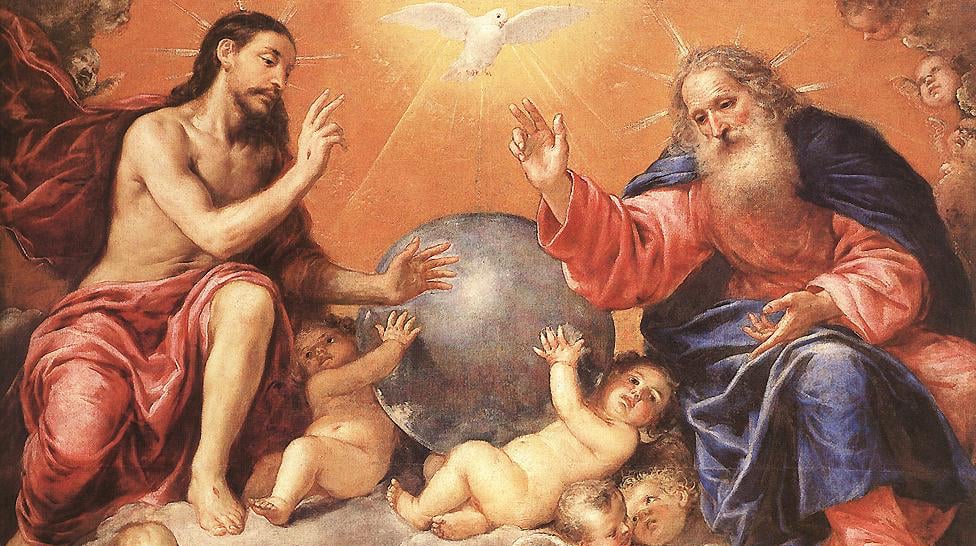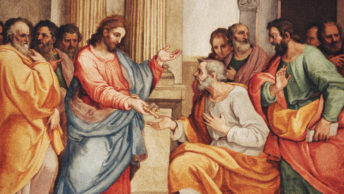Part 1 documented that “Outside the Church there is no salvation” has been a consistent Catholic teaching for many centuries. Part 2 examined the current confusion that surrounds the doctrine and ended by wondering whether that confusion is a sign that the Holy Spirit is prompting the Catholic Church toward a significant reform of its teaching. This essay addresses that possibility and the difficulties surrounding it.
The possibility that the Holy Spirit is prompting the Catholic Church to reform its doctrine of salvation raises a host of difficult questions, the most significant of which are these:
Is there really a need to change Catholic teaching on salvation? It is true that today’s “reformulation” of the teaching is softer and more nuanced than the teaching of the past millennium, yet the earlier teaching has never been renounced, nor has the Church ever expressed regret for promulgating it. Until both are done, the new, non-Catholic friendly version will be nothing more than a thin veneer on the harsh traditional view. The following passage from Pope Eugene IV’s Cantate Domino should leave no doubt how painful the historic teaching was, and remains, for pagans, Jews, heretics, schismatics, and non-Catholic Christians:
[The Church] firmly believes, professes, and proclaims that those not living within the Catholic Church, not only pagans, but also Jews and heretics and schismatics cannot become participants in eternal life, but will depart “into everlasting fire which was prepared for the devil and his angels” unless before the end of life the same have been added to the flock . . . and that no one, whatever almsgiving he has practiced, even if he has shed blood for the name of Christ, can be saved, unless he has remained in the bosom and unity of the Catholic Church.
Eugene and the legion of other popes, bishops, and theologians who have held the same view over the centuries no doubt sincerely believed what they said. They also were able to interpret scripture in a way that supported their thoughts and, far from believing their warnings about damnation to be offensive, likely regarded them as a great kindness to non-Catholics.
Nevertheless, to non-Catholics and, indeed, to large numbers of Catholics, consigning billions of the Church’s neighbors to hell-fire seems incompatible with the image of a loving God. To them, moreover, the teaching seems presumptuous, and it arguably repelled more people than it attracted to the cause of Christian unity—“that all may be one.”
For these reasons terms like “reformulation,” “development,” and other euphemisms may be considered both intellectually unsatisfying and morally wanting. Jesus said when an offense has been given, the offender is obligated to acknowledge what he did, seek forgiveness, and make amends. (“Therefore if you are presenting your offering at the altar, and there remember that your brother has something against you, leave your offering there before the altar and go; first be reconciled to your brother, and then come and present your offering” Matt 5: 23-24.) Simply changing the wording of a teaching that millions of people consider offensive does not satisfy the three requirements stated by Jesus.
Why does the Church find it difficult to change its teachings and/or to acknowledge having done so? From the beginning, the mission of conveying the Gospel accurately and faithfully to all generations has been an enormous responsibility for the Church. It therefore required an organizational structure that ensured consistency of teaching. Accordingly, the Church borrowed from the Roman Empire the concept of canon law and the system of decrees and proclamations, notably dogmatic and pastoral constitutions, encyclicals, and bulls. In the Middle Ages, the Church adopted the somewhat different monarchical model, with authority vested in a king/queen, or in the case of the Church, a pope. (Papal authority existed first, of course; the monarchical model simply reinforced and emphasized it.)
The Church preserved its authority and doctrine by identifying heresies—roughly 58 of them—and when heretics refused to recant, using condemnation, inquisition, excommunication, and censorship against them. Such treatment of religious dissenters may seem outrageous to people who live in a modern democratic republic like the U.S., but for many centuries the great majority of people were uneducated and many, perhaps most, were barely literate. Clerics were therefore the only ones capable of guiding them in separating the Church’s teaching from opposing thought.
Over the centuries, cultural changes created new challenges to the Church and threatened its spiritual and intellectual dominance. The most significant changes were two great schisms, the Renaissance, the Reformation, the invention of the printing press, the Enlightenment, the American and French Revolutions, Darwinism, Capitalism, the Industrial Revolution, mass education, and the development of anthropology, sociology and psychology, all three of which raised questions about the Church’s theological and philosophical teachings.
Despite such formidable challenges, the Church has shown remarkable constancy, first in its commitment to the Gospel, and secondly in the organizational structure and authoritarian framework that it had maintained for the better part of two millennia. The first kind of constancy is both understandable and laudable. The second is understandable but unfortunate—understandable because of the need to maintain its approach in the midst of an unending series of crises. Unfortunate for several reasons:
The Church has retained to the present a rigid monarchical structure that is not reflective of relationships in modern democratic societies. It has Pontiffs, Cardinals, Bishops, and the laity, in capacities roughly comparable to those of Kings, Dukes, and serfs.
It has maintained the elevated status of popes, cardinals, and bishops by the continued use of the terms “hierarchy” (“a system of organizing people into different ranks or levels of importance”) and “magisterium” (“the authority, office, and power to teach true doctrine by divine guidance”), as well as by clothing that signifies such status. These have created a symbolic barrier to communication with the laity. (The wearing of vestments during the Sacrifice of the Mass is, of course, creates no such barrier.)
It has continued and in recent decades increased the practice of communication by highly formal pronouncements—Apostolic Letters, Encyclicals, and Bulls—and by increasing the use of terms such as “definitive,” often with the added designation “not open for discussion,” which suggest to the laity, “don’t think about, weigh, and consider this; just accept it unquestioningly.” With more and more people achieving higher and higher education today, and more societies embracing freedom of thought and speech, such condescension is increasingly counter-productive.
It has continued to give the impression, and sometimes to state directly, that Catholic teaching in general, and especially teaching on matters of faith and morals, never change, though historical studies such as John Noonan’s A Church that Can and Cannot Change have established that it does. In times past, this idea instilled in the laity a sense of confidence and security, but for many people, it no longer does.
What is the greatest single obstacle to changing the Church’s doctrine of Salvation? I submit it is the fear that changing such a central teaching would undermine the Church’s mission to spread the Gospel, diminish the Church’s credibility, and cause even more Catholics to leave the Church. This fear has been evident even in theological issues of less importance. The history of the Church’s teaching of a related matter, the doctrine concerning Limbo, illustrates this fear:
From the earliest times the Church wrestled with the question of whether infants who die without being baptized can enter heaven. As the Catholic Encyclopedia (1910 edition) explains, St. Augustine and the African Fathers believed that “unbaptized infants share in the common positive misery of the damned,” with St. Augustine adding that their misery is mild. Pope Innocent III differed slightly, writing: “[Those dying with only original sin on their souls will suffer] no other pain, whether from material fire or from the worm of conscience, except the pain of being deprived forever of the vision of God.” St. Thomas Aquinas differed more dramatically with Augustine, arguing that the infants would experience no pain at all but only, in the Encyclopedia’s words, “perfect natural happiness.”
St. Robert Bellarmine did not side with Aquinas because he believed the issue had been settled, de fide, in favor of Augustine. However, many other theologians shared Aquinas’ judgment and the Church’s official teaching came to be that unbaptized infants who die go to Limbo, which the Encyclopedia defines as “the permanent place or state” where they are “excluded from the beatific vision.”
How did the Church ultimately deal with the issue of Limbo and the fate of unbaptized children? The 1891, 1941, 1994, and 1997 editions of the Catechism of the Catholic Church said nothing at all about it. Not a word! (The only reference to Limbo states that Christ visited there to announce His opening of the gates of Heaven. )It was as if centuries of theological speculation and argument by the finest minds in the Church, as well as various proclamations, including at least one that some regarded as definitive, had never occurred.
Despite its exclusion from the Catechism, however, the controversy over Limbo was not put to rest. Pope John Paul II commissioned a study of it and in 2007, Pope Benedict XVI authorized the publication of the findings, which the commission summarized as follows:
The affirmation that infants who die without Baptism suffer the privation of the beatific vision has long been the common doctrine of the Church, which must be distinguished from the faith of the Church. As for the theory that the privation of the beatific vision is their sole punishment, to the exclusion of any other pain, this is a theological opinion, despite its long acceptance in the West. The particular theological thesis concerning a “natural happiness” sometimes ascribed to these infants likewise constitutes a theological opinion.
The Commission’s summary was presumably intended to be precise, but it is anything but. It classifies the teaching about Limbo as “common doctrine” that is to be distinguished from “the faith of the Church.” This is a strange distinction because doctrine is generally understood as part of “the faith of the Church.” (Another part is dogma; still others are infallible, definitive, and authoritative teachings. Each, of course, commands a different level of assent.)
The summary also mistakes the competing historical views of Limbo. They are (1) privation of the beatific vision without other punishment, (2) privation with other punishment, and (3) no privation at all, only natural happiness. Most troubling, however, is the commission’s reclassification of the views as theological opinions. The fact that for centuries each of the views was given higher status, and one of them was even considered by some (including St. Robert Bellarmine) to be settled, unchangeable doctrine, suggests that the reclassification needed to be, at very least, more fully explained.
Readers of the Commission report were left wondering why after centuries of debate and a number of firmly advanced theological positions on the issue, the Church’s doctrine has become, “it’s all a matter of opinion,” which comes dangerously close to “whatever.” The report attempts to address the question, but manages only this: “When the question of infants who die without baptism was first taken up in the history of Christian thought, it is possible that the doctrinal nature of the question or its implications were not fully understood. Only when seen in light of the historical development of theology over the course of time until Vatican II does this specific question find its proper context within Catholic doctrine.”
Let’s examine that more closely: The first sentence says that St. Augustine, St. Aquinas, Pope Innocent, St. Bellarmine, and numerous other great thinkers possibly did not understand “the doctrinal nature of the question or its implications.” What an insult to those great men. The second sentence suggests that the “proper context [of the Limbo issue] within Catholic doctrine” is “it’s all a matter of opinion.” What an insult to the intelligence of all who read the report.
The Commission report was 67 pages long and included 135 endnotes, surely an expansive enough document to have dealt more meaningfully with the central matter the Commission was assembled to illuminate. So why did it fail to do so? I submit for the same reason that infant Limbo is not mentioned in any edition of the Catechism of the Catholic Church—fear of acknowledging errors in Church teaching or even the division of theological thought that might imply error.
That same fear, greatly magnified, is the major obstacle to the Church changing its teaching that “Outside the Church there is no salvation.” Is this fear rational or irrational? Is it consistent or inconsistent with faith in the Holy Spirit’s guidance? Would changing this teaching undermine the Church’s mission to spread the Gospel or strengthen it, diminish the Church’s credibility or enhance it, cause Catholics to leave the Church or draw others to it? Part 4 of this essay will address these questions.
Copyright © 2018 by Vincent Ryan Ruggiero. All rights reserved








